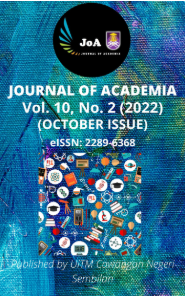SCREENING OF LOW OXALATE CONTENT IN M1V4 MUTANT LINE OF TARO (Colocasia esculenta) CV. WANGI
Keywords:
Total oxalate, corm, taro, Colocasia esculenta, permanganometric titrationAbstract
Raw taro causes unpleasant sensations such as prickliness or itchiness, hence it needs to be cooked
before consumption. It is caused by calcium oxalate that formed as needle-shaped crystals in parts of
taro, Colocasia esculenta. The purpose of this study is to determine the effects of chronic gamma
irradiation in local taro cultivar, Wangi to its oxalate content. The effect of gamma irradiation in mutant
line of taro, M1V4 to reduce the oxalate content was discussed. Using volumetric analysis, total oxalate
content is significantly reduced in the treatment groups as compared to the control group. Treatment
groups 1 (0.66 Gy) and 2 (0.33 Gy) that has been exposed to the highest dosages of chronic gamma
irradiation reported the lowest oxalate contents among the samples. The results analyzed with one-way
ANOVA and least significant difference (LSD) test supported that a higher dosage of gamma irradiation
affected the oxalate content in the corms adversely. Although chronic gamma irradiation is found to be
capable of reducing oxalate content in taro corms, precise and critical methods should be employed to
evaluate for low oxalate content in taro mutant lines.
References
Ahmad, F., Ahmad, Z., Hassan, A. A., Ariffin, S., Noordin, N., Salleh, S., Hussein, S., Akil, M., Sani, M. Z.,
Harun, A. R., & Rahim, K. A. (2018). A review on gamma greenhouse as a chronic gamma irradiation facility for
plant breeding and improvement program. Jurnal Sains Nuklear Malaysia, 30(1), 8-18.
Ahuja, S., Kumar, M., Kumar, P., Gupta, V. K., Singhal, R. K., Yadav, A., & Singh, B. (2014). Metabolic and
biochemical changes caused by gamma irradiation in plants. Journal of Radioanalytical and Nuclear
Chemistry, 300(1), 199-212.
Gouveia, C. S., Ganança, J. F., Lebot, V., & de Carvalho, M. Â. (2018). Quantitation of oxalates in corms and
shoots of Colocasia esculenta (L.) Schott under drought conditions. Acta Physiologiae Plantarum, 40(12), 1-11.
Hasan, N. A., Suhaimi, L., Suhaimi, L., Faiz Ahmad, Bahari, U. M., Abdul Rahim Harun, & Rafii, M. Y. (2020).
Effects of chronic gamma irradiation on the growth of local taro variety (Colocasia esculenta L WANGI). Jurnal
Sains Nuklear Malaysia, 32(2), 23-30.
Hang, D. T., Binh, L. V., Preston, T. R., & Savage, G. P. (2011). Oxalate content of different taro cultivars grown
in central Viet Nam and the effect of simple processing methods on the oxalate concentration of the processed
forages. Livestock Research for Rural Development, 23(6), 2-9.
Kaushal, P., Kumar, V. & Sharma, H. K. (2015). Utilization of taro (Colocasia esculenta): A review. Journal of
Food Science and Technology, 52, 27–40.
Kristl, J., Sem, V., Mergeduš, A., Zavišek, M., Ivančič, A., & Lebot, V. (2021). Variation in oxalate content
among corm parts, harvest time, and cultivars of taro (Colocasia esculenta (L.) Schott). Journal of Food
Composition and Analysis, 102, 2-8.
Mabhaudhi, T., Modi, A. T., & Beletse, Y. G. (2014). Parameterisation and evaluation of the FAO-AquaCrop
model for a South African taro (Colocasia esculenta L. Schott) landrace. Agricultural and Forest Meteorology, Marcu, D., Damian, G., Cosma, C., & Cristea, V. (2013). Gamma radiation effects on seed germination, growth
and pigment content, and ESR study of induced free radicals in maize (Zea mays). Journal of Biological
Physics, 39(4), 625–634.
Mitchell, T., Kumar, P., Reddy, T., Wood, K. D., Knight, J., Assimos, D. G., & Holmes, R. P. (2019). Dietary
oxalate and kidney stone formation. American Journal of Physiology-Renal Physiology, 316(3), F409-F413.
Nakata, P. A. (2003). Advances in our understanding of calcium oxalate crystal formation and function in plants.
Plant Science, 164(6), 901-909.
Nurilmala, F., & Mardiana, D. (2019). Nutrients and anti-nutrients content analysis of bogor taro mutant clone
(Colocasia esculenta). In IOP Conference Series: Earth and Environmental Science, 334(1). IOP Publishing.
Onwueme, I. (1999). Taro cultivation in Asia and the Pacific. RAP Publication, 16, 1-9.
Rashmi, D. R., Raghu, N., Gopenath, T. S., Palanisamy, P., Bakthavatchalam, P., Karthikeyan, M., Gnanasekaran
A., Ranjith M. S., Chandrashekrappa G. K., & Basalingappa, K. M. (2018). Taro (Colocasia esculenta): An
overview. Journal of Medicinal Plant Studies, 6(4), 156-161.
Siddhuraju, P., Makkar, H. P. S., & Becker, K. (2002). The effect of ionising radiation on antinutritional factors
and the nutritional value of plant materials with reference to human and animal food. Food Chemistry, 78(2), 187
Singh, B., & Datta, P. S. (2010). Effect of low dose gamma irradiation on plant and grain nutrition of wheat.
Radiation Physics and Chemistry, 79(8), 819-825.
Zulkhairi, A. M., Razali, M., Umikalsum, M. B., Norfaizal, G. M., Athirah, A. A., & Aisyah, M. S. (2020).
Determination of Oxalates in Corms of Selected Taro (Colocasia esculenta) Varieties in Malaysia Using Ultra
High-Performance Liquid Chromatography. Asian Journal of Chemical Sciences, 7(3), 28-37.
Downloads
Published
Issue
Section
License
Copyright (c) 2022 Journal of Academia

This work is licensed under a Creative Commons Attribution-NonCommercial-NoDerivatives 4.0 International License.












